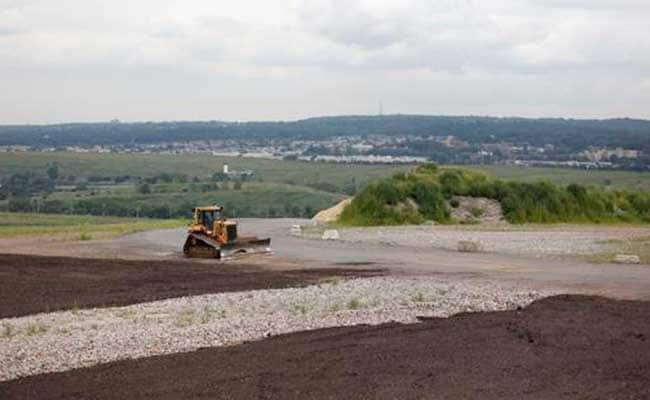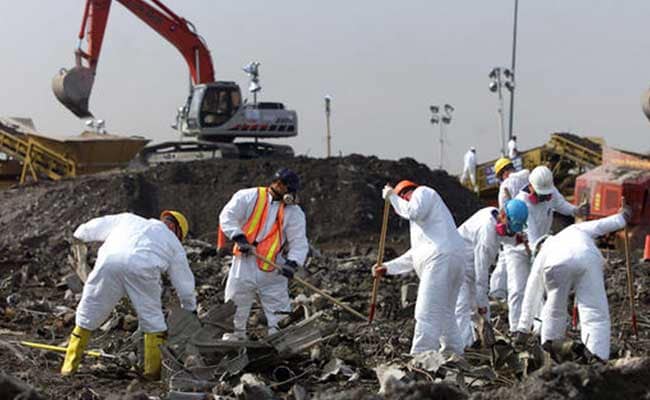
A section of the Freshkills Park is seen in the borough of Staten Island, New York (AP)
New York:
Diverse wildlife habitat. Acres of hilly grasslands. Creeks for kayaking and meadow trails for hiking and biking.
This vibrant landscape at the edge of New York City was once Fresh Kills, the massive, stinking dump for Gotham's garbage.
Today, the 2,200-acre site on Staten Island is well on its way to becoming Freshkills Park, the largest landfill-to-park project in the world.
The park won't be fully complete until 2035, but some sections are already accessible on a limited basis to tour and school groups. Since 2010, it has hosted nature hikes, bird-watching groups, kite-flying excursions and kayaking tours.
Later this month, 700 acres will temporarily open to the public for one of the park's triannual "Discovery Days."
"We have something almost every weekend," said Cait Field, the park's manager for science and research development.
 Visitors who knew the old Fresh Kills said the transformation, while incomplete, is remarkable.
Visitors who knew the old Fresh Kills said the transformation, while incomplete, is remarkable.
New York City Audubon naturalist Clifford Hagen, who leads bird-watching tours through Freshkills, remembers the putrid smells growing up about five miles east of the landfill's 225-foot mountains of trash - now capped with a protective liner and a layer of clean soil.
Today, there are "just the natural smells of the marshes as the tides rise and fall," he said.
"It's always a special moment for everybody when they first walk onto the site," said Hagen. "Then once you get on top of the mountains, you can look out at the industry of New Jersey and you can look at the Freedom Tower in Manhattan and all of the commercial development right outside in Staten Island and you realize you are in the middle of New York City."
On a recent tour, the park was a tranquil place without a hint of fetid odor. The gulls that once fed on 150 million-tons of household trash have been replaced by nearly 200 species of birds. Osprey sat high on nests along the creeks and hawks flew overhead.
For five decades after its opening in 1948, Fresh Kills was the principal landfill for the city's garbage.
 The last barge of regular trash was delivered in 2001 when the site was closed by Mayor Rudy Giuliani, partly in response to Staten Island residents who had complained loudly about being the city's dumping ground.
The last barge of regular trash was delivered in 2001 when the site was closed by Mayor Rudy Giuliani, partly in response to Staten Island residents who had complained loudly about being the city's dumping ground.
Today, the city's garbage is sent to landfills in South Carolina, Virginia and a waste-to-energy plant in New Jersey.
The landfill reopened for several months after 9/11 when more than 1 million tons of material from the World Trade Center site was screened and sifted there.
Three of the landfill's four mountains of trash are capped; More than $600 million has been spent cleaning and beautifying the place.
Permanent public access to the park will be phased in, with 21-acres of a larger 233-acre section opening in 2019 that will include meadows, wetlands and creeks, a climbing tower, recreational paths, and a seed farm of native plants. Another 482 acres will open a year or two later and offer catch-and-release fishing among other activities.
Park Administrator Eloise Hirsh said the site offers "big sky country views," not found anywhere else in the city.
The landscape still bears some scars. The park is dotted with extraction wells that have been collecting gas from the decomposing waste. With each passing year less landfill gas will be produced. Those wells will eventually be shut down and closed off.
A treatment plant on site handles leachate that seeps from the capped landfill daily, although each year less liquid comes out because the cap keeps new rainwater from entering the waste.
The cap's multi-layers include up to 15-to-20-inches of soil, a gas venting layer, an impermeable plastic liner to control runoff, protection material and erosion mats for planting soils.
State regulatory requirements call for a 30-year post-closure monitoring by the sanitation department.
The land is safe for wildlife, officials said, providing resting and nesting areas for dozens of migrating birds, as well as the largest colony of grasshopper sparrows in the northeast. Blue grosbeak, diamondback terrapins and northern snapping turtles also are spotted regularly.
The wildlife is "really a good opportunity to do public education and outreach to show people how actually productive a location this is," said Field. "It's become a habitat that's missing in the region so it has new value in its new life."
This vibrant landscape at the edge of New York City was once Fresh Kills, the massive, stinking dump for Gotham's garbage.
Today, the 2,200-acre site on Staten Island is well on its way to becoming Freshkills Park, the largest landfill-to-park project in the world.
The park won't be fully complete until 2035, but some sections are already accessible on a limited basis to tour and school groups. Since 2010, it has hosted nature hikes, bird-watching groups, kite-flying excursions and kayaking tours.
Later this month, 700 acres will temporarily open to the public for one of the park's triannual "Discovery Days."
"We have something almost every weekend," said Cait Field, the park's manager for science and research development.

Fresh soil on the last section of un-capped landfill in the Park in the borough of New York. (AP)
New York City Audubon naturalist Clifford Hagen, who leads bird-watching tours through Freshkills, remembers the putrid smells growing up about five miles east of the landfill's 225-foot mountains of trash - now capped with a protective liner and a layer of clean soil.
Today, there are "just the natural smells of the marshes as the tides rise and fall," he said.
"It's always a special moment for everybody when they first walk onto the site," said Hagen. "Then once you get on top of the mountains, you can look out at the industry of New Jersey and you can look at the Freedom Tower in Manhattan and all of the commercial development right outside in Staten Island and you realize you are in the middle of New York City."
On a recent tour, the park was a tranquil place without a hint of fetid odor. The gulls that once fed on 150 million-tons of household trash have been replaced by nearly 200 species of birds. Osprey sat high on nests along the creeks and hawks flew overhead.
For five decades after its opening in 1948, Fresh Kills was the principal landfill for the city's garbage.

The last barge of regular trash was delivered in 2001 when the site was closed. (AP)
Today, the city's garbage is sent to landfills in South Carolina, Virginia and a waste-to-energy plant in New Jersey.
The landfill reopened for several months after 9/11 when more than 1 million tons of material from the World Trade Center site was screened and sifted there.
Three of the landfill's four mountains of trash are capped; More than $600 million has been spent cleaning and beautifying the place.
Permanent public access to the park will be phased in, with 21-acres of a larger 233-acre section opening in 2019 that will include meadows, wetlands and creeks, a climbing tower, recreational paths, and a seed farm of native plants. Another 482 acres will open a year or two later and offer catch-and-release fishing among other activities.
Park Administrator Eloise Hirsh said the site offers "big sky country views," not found anywhere else in the city.
The landscape still bears some scars. The park is dotted with extraction wells that have been collecting gas from the decomposing waste. With each passing year less landfill gas will be produced. Those wells will eventually be shut down and closed off.
A treatment plant on site handles leachate that seeps from the capped landfill daily, although each year less liquid comes out because the cap keeps new rainwater from entering the waste.
The cap's multi-layers include up to 15-to-20-inches of soil, a gas venting layer, an impermeable plastic liner to control runoff, protection material and erosion mats for planting soils.
State regulatory requirements call for a 30-year post-closure monitoring by the sanitation department.
The land is safe for wildlife, officials said, providing resting and nesting areas for dozens of migrating birds, as well as the largest colony of grasshopper sparrows in the northeast. Blue grosbeak, diamondback terrapins and northern snapping turtles also are spotted regularly.
The wildlife is "really a good opportunity to do public education and outreach to show people how actually productive a location this is," said Field. "It's become a habitat that's missing in the region so it has new value in its new life."
Track Latest News Live on NDTV.com and get news updates from India and around the world

